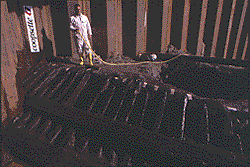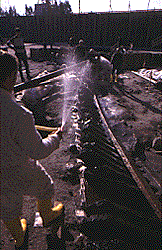
|
|
Ship A
|
"A Cache of Vintage Ships"
Volume 52 Number 4, July/August 1999
|
|
|

Builders discovered the first wreck when it was bisected by a steel retaining wall installed to support the sides of the foundation pit. It has now been reburied to protect it until it can be moved; before that, excavators had to keep it constantly moist to prevent the wood from deteriorating. |  |
Though study of the ships is only beginning, the nine found so far seem to be utilitarian vessels like coastal freighters and small harbor craft rather than men of war. The first wreck to be found, dubbed ship A by the excavators, was empty, but the vessel's structure is exceptionally well preserved. Floor timbers (which ran from side to side across the bottom of the ship), stringers (timbers running from bow to stern), and hull planks survive practically intact for a length of 25 feet. Neither bow nor stern was found, but the ship extends beyond the walls of the foundation pit and one end may exist in unexcavated soil. The exposed portion has been reburied to protect it until it can be moved to a conservation facility; the unexcavated part will be uncovered in the future.
Based on stratigraphy and associated finds, Bruni believes ship A dates from the mid-second century A.D., when Pisa had dwindled to a local port serving a stretch of the Ligurian coast. According to Lionel Casson, a specialist in ancient ships and shipping, the vessel was at least twice as long as the exposed 25-foot portion, an "average small coastal freighter" that could have hauled cargo of any kind from port to port along the coast. That the ship was empty suggests several potential scenarios: its cargo was unloaded before it sank; amphoras or other durable goods were recovered in antiquity shortly after it sank; or sacks of grain or other perishables decomposed, leaving no trace. 
Introduction | Ship A |
Ship B | Ship C | Ship D | Other Ships | A New Museum?

© 1999 by the Archaeological Institute of America
archive.archaeology.org/9907/etc/shipa.html |

